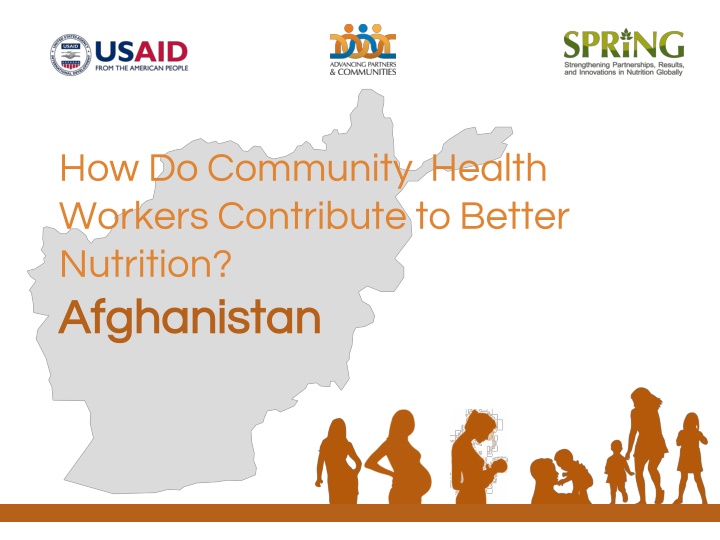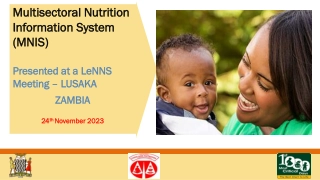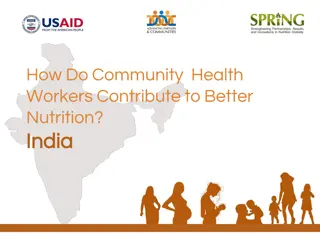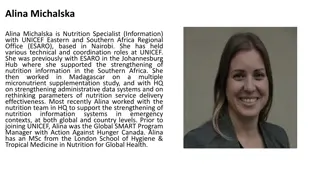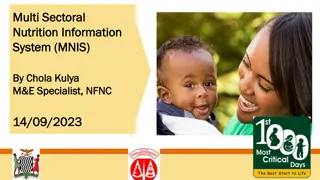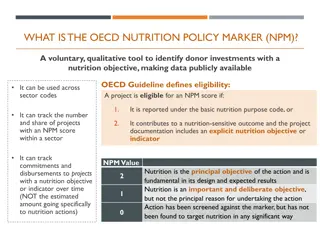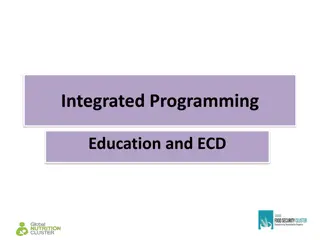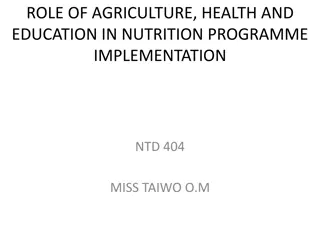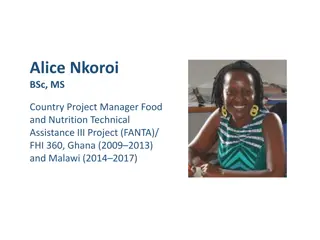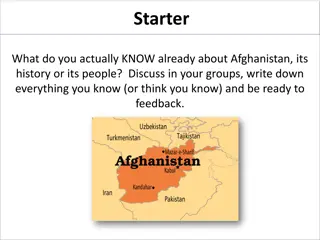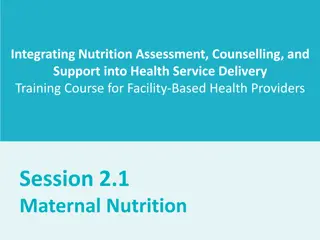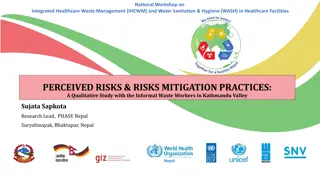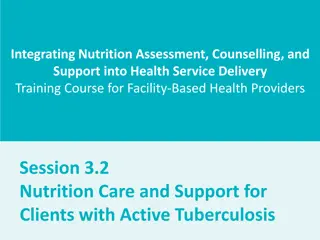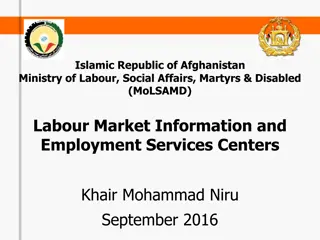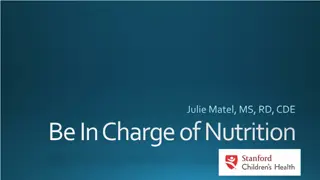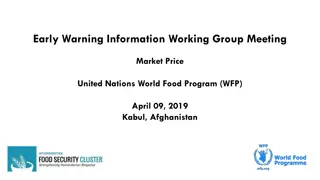Enhancing Nutrition Through Community Health Workers in Afghanistan
Community health workers in Afghanistan play a crucial role in improving nutrition outcomes for maternal and child health. The SPRING and APC projects focus on strengthening partnerships and scaling up high-impact nutrition practices through community programs. By leveraging the support and tools provided, stakeholders can prioritize services, build stronger policies, and effectively plan and support community health workers to enhance nutrition interventions.
Download Presentation

Please find below an Image/Link to download the presentation.
The content on the website is provided AS IS for your information and personal use only. It may not be sold, licensed, or shared on other websites without obtaining consent from the author.If you encounter any issues during the download, it is possible that the publisher has removed the file from their server.
You are allowed to download the files provided on this website for personal or commercial use, subject to the condition that they are used lawfully. All files are the property of their respective owners.
The content on the website is provided AS IS for your information and personal use only. It may not be sold, licensed, or shared on other websites without obtaining consent from the author.
E N D
Presentation Transcript
How Do Community Health Workers Contribute to Better Nutrition? Afghanistan Afghanistan
About About SPRING SPRING The Strengthening Partnerships, Results, and Innovations in Nutrition Globally (SPRING) project is a five-year USAID-funded Cooperative Agreement to strengthen global and country efforts to scale up high-impact nutrition practices and policies and improve maternal and child nutrition outcomes. The project is managed by JSI Research & Training Institute, Inc., with partners Helen Keller International, The Manoff Group, Save the Children, and the International Food Policy Research Institute. About About APC Advancing Partners & Communities (APC) is a five-year cooperative agreement funded by the U.S. Agency for International Development under Agreement No. AID-OAA-A-12-00047, beginning. APC is implemented by JSI Research & Training Institute, Inc., in collaboration with FHI 360. The project focuses on advancing and supporting community programs that seek to improve the overall health of communities and achieve other health-related impacts, especially in relationship to family planning. APC provides global leadership for community-based programming, executes and manages small-and medium-sized sub-awards, supports procurement reform by preparing awards for execution by USAID, and builds technical capacity of organizations to implement effective programs. APC Disclaimer Disclaimer This report is made possible by the generous support of the American people through the United States Agency for International Development (USAID) under the terms of the Cooperative Agreement AID-OAA-A-11-00031 (SPRING), managed by JSI Research & Training Institute, Inc. (JSI). The contents are the responsibility of JSI and do not necessarily reflect the views of USAID or the United States Government. Recommended Citation Recommended Citation SPRING and APC. 2016. How Do Community Health Workers Contribute to Better Nutrition?: Afghanistan. Arlington, VA: Strengthening Partnerships, Results, and Innovations in Nutrition Globally (SPRING) project. SPRING SPRING JSI Research & Training Institute, Inc. 1616 Fort Myer Drive, 16th Floor Arlington, VA 22209 USA Phone: 703-528-7474 Fax: 703-528-7480 Email: info@spring-nutrition.org Internet: www.spring-nutrition.org
How to use these slides We invite in-country stakeholders to use this information to: Identify Identify which nutrition-related services CHWs can provide, according to policies; Prioritize Prioritizeand/or reassign responsibilities to avoid overburdening CHWs; Build Build a stronger foundation of policies, tools, and systems for CHWs to conduct their work; Plan Plan additional support to CHWs; Design Design and conduct other in-depth assessments of community nutrition programs; Inform Inform program implementers to strengthen community health interventions. These were developed using information collected by APC, with input from SPRING, through a desk review of existing policies and documents related to community health systems. Due to the diversity and magnitude of community health programs in a given country, we collected information based on country policies/strategies that comprise the key areas of a community health system and not the realities of program implementation. Due to funding and timing, we focused on national public sector programs, and only when possible, captured community-based privatesector health programsoperatingat scale.We encourageupdatesand validationto specificlocal contexts.
In Afghanistan, nutrition nutrition- -related health issues related health issues persist. According to most recent data, stunting remains a major challenge in Afghanistan. stunting 33% 33% % children under 5 of women of reproductive age have anemia 59 53 That means 2.3 million women have a critical micronutrient deficiency (2011) 2.3 million Afghan 41 1997 2004 2013 Anemia Anemia also persists as a major issue for Afghanistan s children. o only nly 54% 54% of infants are exclusively breastfed for 6 months (2011) 53.4 51.6 % children under 5 45.4 44.2 41.9 1996 1997 2001 2006 2011 Source: World Bank Databank: Global Nutrition Report Profile
We know evidence interventions interventions can improve nutrition outcomes. evidence- -based, cost based, cost- -effective effective It is estimated that the following 10 evidence-based, nutrition-specific interventions, if scaled to 90 percent coverage, could reduce stunting by 20 percent percent and severe wasting by 60 severe wasting by 60 percent percent. reduce stunting by 20 Management of severe acute malnutrition Preventive zinc supplementation Promotion of breastfeeding Appropriate complementary feeding Management of moderate acute malnutrition Periconceptualfolic acid supplementation or fortification Maternal balanced energy protein supplementation Maternal multiple micronutrient supplementation Vitamin A supplementation Maternal calcium supplementation Source: Bhutta et al. 2013.
Studies have demonstrated the effectiveness of community health workers in achieving demonstrable health benefits directly related to the Millennium Development Goals (MDGs), including reducing child reducing child malnutrition and both child and malnutrition and both child and maternal mortality. maternal mortality. - Perry and Zulliger (2012)
Community Community health workers health workers play providing these proven, evidence-based, cost- effective interventions. play a critical role a critical role in By making basic primary care available at the community level, CHWs make it possible for women and children to receive the services they need for better health outcomes. Frequently based in the communities where they are from, community health workers (CHWs) have direct access to the community and can link with other nutrition-related community- based service providers. They can provide clients with a range of services such as medical care, information, counseling, and referral. However, CHWs are often expected to carry out a wide range of interventions with limited time, resources, and remuneration. They need appropriate academic curricula, training programs, and support systems including systems for monitoring, supporting, and mentoring. Countries like Afghanistan take this into consideration as they scale up and expand the services provided by CHWs. Afghanistan must
Informa Informati tion workers provide and the systems that support them in doing their work is often hard to find is often hard to find. on on the services that community health To begin to fill this void, the two USAID-funded projects - Advancing Advancing Partners and Communities (APC) Partners and Communities (APC) andStrengthening Partnerships Partnerships , Results, , Results, and Innovations in Nutrition Globally and Innovations in Nutrition Globally (SPRING) (SPRING) - - collaborated to conduct a desk review of existing policies and documents related to community health systems. Strengthening Due to the diversity and magnitude of community health programs in a given country, we collected information based on individual country policies/strategies that comprise the key areas of a community health system and not the realities of program implementation. Due to funding and timing, we focused on national public sector programs, and only when possible, captured community-based private sector health programs operating at scale.
These are our findings: This is what community health workers can do in Afghanistan, according to government policy. See the Data Notes at the end for more on how data were collected and analyzed.
Community health service delivery in Afghanistan is guided by multiple policies. multiple policies. Relevant Government Policies Reviewed Last Updated A Basic Package of Health Services for Afghanistan 2010 2010 Community-Based Health Care Strategy (2015-2020) 2015
Afghanistan has one main cadre community health workers. one main cadre of Community Health Workers (CHW) Community Health Workers (CHW) the community-level arm of the CBHC program. CHWs conduct health education sessions, promote healthy behaviors, facilitate community mobilization, and provide basic health care services for common and simple illnesses, with a general focus on maternal and child health, FP, and WASH. 28,000 28,000 in country 1: 1,000-1,500 people* in country *Equivalent to approximately 100 150 families
Community health workers in Afghanistan provide services in multiple health service delivery areas. multiple health service delivery areas. Services provided by CHWs Services not provided by CHWs Family planning Maternal and child health Integrated community case management HIV/AIDS Nutrition How is training training managed for CHW cadres? Malaria Tuberculosis National training National training c curriculum urriculum is available Nutrition is included Nutrition is included in the training curriculum Immunization Water and sanitation
Community health workers in Afghanistan support improved nutrition outcomes throughout the continuum of care.
How we present our findings How we present our findings on nutrition services provided by community health workers. Services, listed in tables, are categorized as nutrition a assessment c counseling ounseling, or support support actions. ssessment, The tables presented for each stage of life across the continuum of care include specific nutrition-related services queried as part of the Community Health Systems Catalog Assessment. Assessment Activity / action to be taken For each stage of life, we indicate if the service is provided by community health workers and which cadres have the responsibility to provide that service. Counseling Support Service not provided by CHWs or not clearly specified in policy Services provided by CHWs
For adolescents Counseling Provide information/education/counseling (IEC) on iron/folate for women who are not pregnant and adolescent girls Support Provide/administer iron/folate for women who are not pregnant and adolescent girls
For pregnant women Assessment Monitor weight gainduring pregnancy Measure mid-upperarm circumference (MUAC) screening for pregnant women Give information on hemoglobintesting for women who are pregnant Test blood for hemoglobin levels Counseling Provide IEC on nutrition/dietarypractices during pregnancy Provide IEC on iron/folate Provide IEC on insecticide-treated net use Support Provide/administer insecticide-treated nets Provide/administeriron/folate
For breastfeeding women Assessment Monitor nutritional status of women who are breastfeeding (e.g., using MUAC) Counseling Provide IEC on correct positioning and attachment of the newborn during breastfeeding Provide IEC on managing breastfeeding problems (breast health, perceptions of insufficient breast milk, etc.) Provide IEC on nutrition/dietary practices during lactation
For newborns Assessment Weighnewborns Counseling Provide IEC on skin-to-skin contact between baby and mother/caregiver Provide IEC on breastfeeding within 1 hour of birth
For children Counseling Assessment Provide IEC on VitaminA for children 6 59 months of age Scales to measure weight of children up to 2 years of age Provide IEC on generalmicronutrient supplementation Use length boards to measure length of children up to 2 years of age Provide IEC on de-worming medication Measure MUAC of children Screen children for bilateral edema Provide IEC on complementary feeding practices and continued breastfeeding (6 23 months of age) Support ProvideIEC on exclusive breastfeeding (first 6 months of age) Provide/administerVitamin A supplementation for children 6 59 months of age Provide IEC on introduction of soft, semi-solid foods at 6 months of age ProvideIEC on continuing breastfeeding for children less than 6 months of age who have diarrhea Provide/administermicronutrient supplementation Provide/administerdeworming medication Provide IEC on increasing fluids and continuing solid feeding for children over 6 months of age with diarrhea Treating moderate acute malnutrition for children under 2 years of age Treat severeacute malnutrition with ready-to-use therapeutic foods (RUTF) or ready-to-use supplementary foods (RUSF)
For all stages of life Counseling Provide IEC on handwashing with soap ProvideIEC on community-level total sanitation Provide IEC on household point-of-use water treatment
Our key takeaways In Afghanistan, CHWs provide 30 recommended 38 38 nutrition services discussed in this assessment. 30 of the Adolescents Services provided by CHWs Pregnant women Service not provided by CHWs or not clearly specified in policy Breastfeeding women Newborns Children All stages of life
Data Notes This effort was undertaken as part of the wider Community Health Systems Catalog data collection effort. This document includes rich information about community- level nutrition policies and services in Afghanistan. The data represented here are based on a detailed analysis of survey responses and a review of select policies related to nutrition responsibilities of community health workers. The data come with their own caveats. Policies do not always specify which particular actions CHWs are allowed or expected to perform, nor do they give any real indication of what actions CHWs actually do perform. Policies can be general, ambiguous, and/or contradictory. For instance, a policy might list "referral for antibiotics" but it doesn't specify which antibiotics. You can find more details on the Community Health System in Afghanistan and data on other countries at: www.advancingpartners.org/ resources/chsc Furthermore, Afghanistan is a highly decentralized country. In some states the policies and guidelines reviewed may not be adopted at all, may be adapted, and/or may be integrated into other documents. You can learn more about how to map health workforce activities with the SPRING Nutrition Workforce Mapping Toolkit, available at spring-nutrition.org/publications/tools/nutrition-workforce- mapping-toolkit
References Bhutta, Zulfiqar A., Jai K. Das, Arjumand Rizvi, Michelle F. Gaffey, Neff Walker, Susan Horton, Patrick Webb, Anna Lartey, Robert E. Black, The Lancet Nutrition Interventions Review Group, the Maternal and Child Nutrition Study Group. 2013. Evidence-based interventions for improvement of maternal and child nutrition: what can be done and at what cost? Lancet 382 (9890):452-477. doi:10.1016/S0140- 6736(13)60996-4. (https://goo.gl/jrMUov) Global Nutrition Report. 2014 Nutrition Country Profile, Afghanistan. 2014. (https://goo.gl/0QZgw9) World Bank DataBank. Health Nutrition and Population Statistics. 2016. World Bank Group: Washington, D.C. (https://goo.gl/w1DrLr) Perry, Roger and Rose Zulliger. 2012. How Effective Are Community Health Workers? An Overview of Current Evidence with Recommendations for Strengthening Community Health Worker Programs to Accelerate Progress in Achieving the Health-related Millennium Development Goals. JHU: Baltimore, MD. (https://goo.gl/3x9K91)
Additional Resources on CHWs Community Health Systems Catalog Community Health Systems Catalog- An innovative and interactive reference tool on country community health systems intended for ministries of health, program managers, researchers, and donors interested in learning more about the current state of community health systems. (https://goo.gl/N1QKYK) Essential Essential Package of Health Services Country Snapshot Series Package of Health Services Country Snapshot Series - A series of country profiles that analyzes the governance dimensions of Essential Packages of Health Services (EPHS), including how government policies contribute to the service coverage, population coverage, and financial coverage of the package (https://goo.gl/2M6FXr) Community Health Worker (CHW) Central Community Health Worker (CHW) Central- An online community of practice for sharing resources and experiences and discussing questions and ideas on CHW programs and policy. (https://goo.gl/dacnl5) The Community Health Framework The Community Health Framework- A framework developed for government decision makers to structure dialogues, answer questions, develop recommendations, and foster continuous learning about community health. (https://goo.gl/VZImbm) Global Experience of Community Health Workers for Delivery of Health Related Millennium Development Goals: A Systematic Revie Global Experience of Community Health Workers for Delivery of Health Related Millennium Development Goals: A Systematic Review, Country Case Studies, and Recommendations for Integration into National Health Systems Country Case Studies, and Recommendations for Integration into National Health Systems - A systematic review of CHW programs and their impact on health-related Millennium Development Goals (MDGs) as well as eight in-depth country case studies in Sub- Saharan Africa (Ethiopia Mozambique and Uganda), South East Asia (Bangladesh, Pakistan and Thailand) and Latin America (Brazil and Haiti). (https://goo.gl/5G0Vbc) w, How Effective Are Community Health Workers? How Effective Are Community Health Workers? An Overview of Current Evidence with Recommendations for Strengthening An Overview of Current Evidence with Recommendations for Strengthening Community Health Worker Programs to Accelerate Progress in Achieving the Health Community Health Worker Programs to Accelerate Progress in Achieving the Health- -related Millennium Development Goals update and supplementto the previous paper on the effectiveness of CHWs in providing a range of health services and improving health and nutrition outcomes. (https://goo.gl/jKx2Zg) related Millennium Development Goals - An
Additional Resources from Afghanistan We were unable to find resources on the provision of nutrition services by CHWs in Afghanistan; however, some of these may be useful: Islamic Republic of Afghanistan Ministry of Public Health Reproductive Health Directorate Safe motherhood Initiative Islamic Republic of Afghanistan Ministry of Public Health Reproductive Health Directorate Safe motherhood Initiative Guidance Note For Scaling Up Coverage of Maternal and Newborn Care Intervention At The Community Level Guidance Note For Scaling Up Coverage of Maternal and Newborn Care Intervention At The Community Level - Guidance intended to provide a framework to support consistent and coordinated implementation of initiative to improve maternal and newborn care practices at household and community level, guide actors working at community level to initiate and scale-up coverage of community based newborn care interventions, and provide opportunity for generating further evidence for strengthening of newborn care in Afghanistan at both facility and community level in a coherent manner. This document serves as a tool for providers of the Basic Package of Health Services (https://goo.gl/bo5dKv) Toward universal coverage in Afghanistan: A multi Toward universal coverage in Afghanistan: A multi- -stakeholder assessment of capacity investments in the community stakeholder assessment of capacity investments in the community health worker system health worker system - This paper outlines the results of a mixed-methods study intended to determine systemic constraints in the CHW system and stakeholders' perspectives and investments at the national, facility and community levels. It discusses a variety of aspects of the health system in Afghanistan, and discusses potential improvements in health policy, structure, and the support system for increased CHW performance. (https://goo.gl/rnVROa) Community health workers of Afghanistan: a qualitative study of a national Community health workers of Afghanistan: a qualitative study of a national program devastating health and social system impacts. Community Health Workers serve as both health organizers and community developers in this multiethnic and multilingual country. This paper aims to examine the CHW program post-conflict in Afghanistan, to identify facilitators and challenges that workers face. (https://goo.gl/iZ7WhV) program- Armed conflicts leave behind
Learn more at: www.spring-nutrition.org
